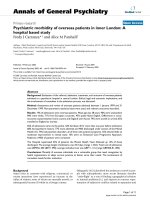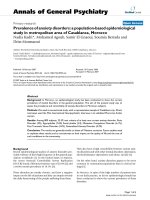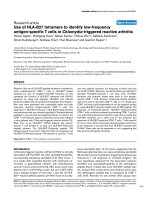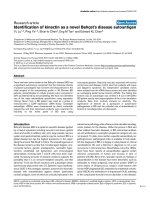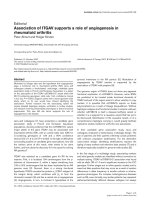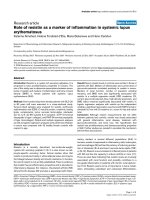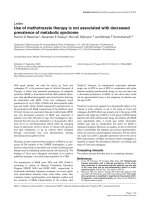Báo cáo y học: "Use of the probiotic Lactobacillus plantarum 299 to reduce pathogenic bacteria in the oropharynx of intubated patients: a randomised controlled open pilot study" pps
Bạn đang xem bản rút gọn của tài liệu. Xem và tải ngay bản đầy đủ của tài liệu tại đây (435.77 KB, 8 trang )
Open Access
Available online />Page 1 of 8
(page number not for citation purposes)
Vol 12 No 6
Research
Use of the probiotic Lactobacillus plantarum 299 to reduce
pathogenic bacteria in the oropharynx of intubated patients: a
randomised controlled open pilot study
Bengt Klarin
1
, Göran Molin
2
, Bengt Jeppsson
3
and Anders Larsson
4
1
Department of Anaesthesiology and Intensive Care, University Hospital, SE-221 85 Lund, Sweden
2
Applied Nutrition and Food Chemistry, Lund University, Box 117, SE-221 00 Lund, Sweden
3
Department of Surgery, University Hospital, SE-205 02 Malmö, Sweden
4
Department of Anaesthesiology and Intensive Care, Aalborg Hospital, Århus University Hospitals, DK-9000 Aalborg, Denmark
Corresponding author: Bengt Klarin,
Received: 2
5 Jun
2008 Revisions requested: 28 Jul 2008 Revisions received: 27 Aug 2008 Accepted: 6 Nov 2008 Published: 6 Nov 2008
Criti
cal Care 2008, 12:R136 (doi:10.1186/cc7109)
This article is online at: />© 2008 Klarin et al.; licensee BioMed Central Ltd.
This is an open access article distributed under the terms of the Creative Commons Attribution License ( />),
which permits unrestricted use, distribution, and reproduction in any medium, provided the original work is properly cited.
Abstract
Introduction Ventilator-associated pneumonia (VAP) is usually
caused by aspiration of pathogenic bacteria from the
oropharynx. Oral decontamination with antiseptics, such as
chlorhexidine (CHX) or antibiotics, has been used as prophylaxis
against this complication. We hypothesised that the probiotic
bacteria Lactobacillus plantarum 299 (Lp299) would be as
efficient as CHX in reducing the pathogenic bacterial load in the
oropharynx of tracheally intubated, mechanically ventilated,
critically ill patients.
Methods Fifty critically ill patients on mechanical ventilation
were randomised to either oral mechanical cleansing followed
by washing with 0.1% CHX solution or to the same cleansing
procedure followed by oral application of an emulsion of Lp299.
Samples for microbiological analyses were taken from the
oropharynx and trachea at inclusion and at defined intervals
thereafter.
Results Potentially pathogenic bacteria that were not present at
inclusion were identified in oropharyngeal samples from eight of
the patients treated with Lp299 and 13 of those treated with
CHX (p = 0.13). Analysis of tracheal samples yielded similar
results. Lp299 was recovered from the oropharynx of all patients
in the Lp299 group.
Conclusions In this pilot study, we found no difference between
the effect of Lp299 and CHX used in oral care procedures,
when we examined the effects of those agents on colonisation
of potentially pathogenic bacteria in the oropharynx of intubated,
mechanically ventilated patients.
Introduction
Ventilator-associated pneumonia (VAP) is a common compli-
cation in intubated, mechanically ventilated patients in inten-
sive care units (ICUs). VAP is connected to longer ICU and
hospital stays, additional costs and high mortality, and the risk
of developing this condition increases by 1% with each addi-
tional day of mechanical ventilation [1,2].
The major cause of VAP is aspiration of either microorganisms
from the oropharynx or fragments of biofilms from the endotra-
cheal tube. Formation of such biofilms can be delayed, but not
prevented, by the use of tubes with special coatings [3].
Selective decontamination using antibiotics in the oral cavity
alone [4-6] or throughout the gastrointestinal (GI) tract [7,8],
has been shown to lower the incidence of VAP and reduce
mortality. However, the use of such procedures is limited due
to the risk of bacteria developing resistance to the antibiotics
[9,10]. In recent meta-analyses, it was concluded that oral
decontamination with chlorhexidine (CHX) could prevent VAP
[11], but that strategy does not reduce the time on the ventila-
tor, the length of stay (LOS) in the ICU or rates of mortality
[12]. Thus, there is a need for alternative approaches to lower
the oropharyngeal load of pathogenic microorganisms as a
means of decreasing the risk of VAP.
APACHE II: Acute Pathophysiology and Chronic Health Evaluation; CFU: colony forming unit; CHX: chlorhexidine; CRP: C reactive protein; GI: gas-
trointestinal; ICU: intensive care unit; LOS: length of stay; LIS: Lung Injury Score; Lp299: Lactobacillus plantarum 299; MRSA: methicillin-resistant
Staphylococcus aureus; SOFA: Sequential Organ Failure Assessment; VAP: ventilator-associated pneumonia; WBC: white blood cells.
Critical Care Vol 12 No 6 Klarin et al.
Page 2 of 8
(page number not for citation purposes)
For decades, probiotics have been given enterally to improve
the microbiotic flora in the GI tract. However, in recent years
orally administered probiotics have also been shown to reduce
the number of bacteria and yeast in biofilms on vocal prosthe-
ses [13,14]. Therefore, we hypothesised that swabbing the
oral mucosa with probiotics would be an effective (and micro-
biologically attractive) method of reducing pathogenic oral
microorganisms in tracheally intubated, mechanically venti-
lated, critically ill patients.
The primary aim of the present pilot study was to evaluate the
feasibility and safety of an oral care procedure using the pro-
biotic Lactobacillus plantarum 299 (Lp299) (DSM 6595) in
this patient category. Like the genomically closely related
strain L plantarum 299v (DSM 9843), Lp299 has been shown
to adhere to the mucosa throughout the GI tract [15-17].
Another objective of this preliminary investigation was to
obtain an estimate of the number of patients needed for a
definitive study examining the effectiveness of oral Lp299 in
reducing the incidence of VAP.
Materials and methods
The study was approved by the Human Ethics Committee of
Lund University and was performed in compliance with the
Helsinki Declaration. Good clinical practice and the Interna-
tional Conference on Harmonisation Guidance were applied
and the investigation was carried out in the ICU of the Depart-
ment of Anaesthesiology and Intensive Care, University Hospi-
tal, Lund, Sweden. Informed consent was obtained from the
patients or their next of kin. Further consent was not obtained
from patients as they had recovered, as this was not required
by the Human Ethics Committee.
The patients were randomised into groups of 10 to receive
either the department's standard oral treatment (the control
group) or the study treatment with Lp299 (the Lp group). The
day of inclusion was designated day 1. To be included in the
study, patients had to fulfil the following criteria: 18 years of
age or older; critically ill with an anticipated need for mechan-
ical ventilation of at least 24 hours; not moribund; not suffering
from pneumonia at admission; no fractures in the facial skele-
ton or the base of the skull; no oral ulcers; not immune defi-
cient; not a carrier of HIV or viral hepatitis.
After screening, patients were included when ventilation and
circulation had been stabilised and before the first oral care
procedure. Oral care was performed twice a day. The control
group was treated according to the department's standard
protocol: dental prostheses were removed; secretions were
removed by suction; teeth were brushed using toothpaste
(Zendium, Opus Health Care, Malmö, Sweden); all mucosal
surfaces were cleansed with swabs that had been moistened
with a 1 mg/ml CHX solution (Hexident, Ipex, Solna, Sweden).
In the Lp group the initial mechanical steps were the same as
in the control group, but the subsequent cleansing was
instead performed with gauze swabs soaked in carbonated
bottled water, after which Lp299 was applied to the mucosal
surface of the oral cavity. This was performed using two gauze
swabs (one for each side of the oral cavity), which had been
allowed to absorb 10 ml of a solution containing a total of 10
10
colony-forming units (CFU) of Lp299. Excess suspension was
not removed. In both groups, when necessary between the
oral care procedures, secretions were removed by suctioning
and gauze swabs moistened with carbonated bottled water
were used to wipe off remaining secretions.
Cultures were taken from the oropharynx and from the trachea
at inclusion. Sampling was repeated before the oral care pro-
cedures on days 2, 3, 5, 7, 10, 14 and 21 in patients that were
still mechanically ventilated. If a patient was extubated on a
non-culture day, cultures were taken before the extubation.
One set of cultures was analysed according to normal routines
at the Department of Clinical Microbiology, University Hospi-
tal. Another set was sent blinded to the research laboratory at
Probi AB, Lund, Sweden for identification and quantification of
total CFU of lactobacilli and identification of Lp299. Viable
counts of all lactobacilli were obtained on Rogosa agar (Oxoid,
Basingstoke, Hampshire, England) incubated anaerobically at
37°C for three days. Colonies suspected to be Lp299 (large,
creamy white-yellowish and somewhat irregular in shape)
were selected and identified by randomly amplified polymor-
phic DNA typing [18].
The patients were placed in a semi-recumbent position and
were ventilated in pressure control or pressure support mode
by a Servo ventilator (Maquet AB, Sweden) via a heat moisture
exchange filter (Barrierbac "S", Mallinckrodt DAR, Mirandola,
Italy). A closed suction system (TRACH-Care 72, Ballard Med-
ical Products, Draper, UT, USA) was used. The patients
inhaled 2.5 mg salbutamol (GlaxoSmithKline, Solna, Sweden)
and 0.5 mg ipratropium (Boehringer Ingelheim, Stockholm,
Sweden) every six hours.
Chest radiographs were obtained after tracheal intubation and
thereafter when clinically indicated. Lung function was
assessed using the Lung Injury Score (LIS) [19]. Blood gases
were obtained at least three times a day and were analysed at
the ICU. Samples for white blood cell (WBC) counts and C-
reactive protein (CRP) were collected daily and analysed at
the hospital clinical chemistry laboratory.
Enteral nutrition was started and increased according to the
department's protocol. The amount of enteral formula given
and the total volume of other enterally administered fluids were
recorded. All patients received intravenous ezomprazol (Astra
Zeneca, Södertälje, Sweden) as stress ulcer prophylaxis from
admission until enteral nutrition was fully established (ie, for
three to four days).
Available online />Page 3 of 8
(page number not for citation purposes)
The study was neither intended nor powered for assessment
of differences in the frequency of VAP. However, it was aimed
at obtaining a basis for estimating the number of patients
needed for a larger investigation in which VAP also constitutes
a parameter. The following criteria were used to identify VAP:
a new, persistent or progressive infiltrate on chest radiograph
combined with at least three of the other four criteria; a puru-
lent tracheal aspirate; positive culture of tracheal aspirates
occurring after 48 hours of mechanical ventilation; rectal or
urine bladder temperature higher than 38.0°C or less than
35.5°C; WBC count more than 12 or less than 3 [4,20].
Statistics
Because no previous investigation has examined the effect of
probiotics in this context, we estimated that 20 patients in
each group would be sufficient to assess the safety, important
positive effects and possible side effects, and to give an indi-
cation of the number of patients that would be needed in a
definitive study. Statistical methods were chosen after con-
sulting a biostatistician, and the statistical analyses were per-
formed using Statistica 6.0 (StatSoft, Tulsa, OK, USA).
Student's t-test was used for the daily comparisons (days1 to
9) of the parameters. Fisher's exact test was employed to com-
pare the results of microbiological cultures. p < 0.05 was con-
sidered significant.
Results
After screening, 50 patients were included in the study. Con-
sent was withdrawn by two patients and another three were
transferred to other ICUs shortly after inclusion. For one
patient in the control group, samples were obtained only at
inclusion. Altogether, 23 patients in the Lp group and 21 in the
control group completed the study.
All patients were orotracheally intubated. Two in each group
were reintubated, and two in the Lp group and one in the con-
trol group were tracheotomised (on days 3, 16 and 3, respec-
tively). The proportion of patients receiving enteric nutrition
and the volumes given were similar in the two groups. The
patients in both groups were treated with antibiotics at the dis-
cretion of the attending physician and changes were made in
compliance with culture results. Cefuroxime was the most
common antibiotic used in both groups, followed by imipenem.
Three patients in each group received piperacillin/tazobactam,
and other antibiotics or combinations were administered to
some patients in each of the two groups. Three patients did
not receive any antibiotics at admission, and one of those
three was not treated with antibiotics during the stay in the
ICU. Ten patients in each group received corticosteroids for
one or more days.
As indicated in Table 1, there were no significant differences
in age or gender between the groups. Also, the admission
diagnoses were similar in the two groups, as were the Acute
Pathophysiology and Chronic Health Evaluation (APACHE) II
scores. Some differences were found in the Sequential Organ
Failure Assessment (SOFA) scores in favour of the Lp patients
(data not shown). The two groups did not differ significantly
with regard to the number of ventilator days, LOS, or ICU or in-
hospital mortality (Table 1). No deaths were caused by respi-
ratory complications and no additional deaths occurred within
six months.
No differences in WBC counts were found between the
groups. Furthermore, the groups did not differ with regard to
changes in CRP, although the absolute values were higher for
the controls on day 3.
No significant differences between the two groups were found
when considering microbiological findings of the oropharyn-
geal and tracheal samples taken at inclusion. The same spe-
cies were identified in samples from both the oropharynx and
the trachea of six Lp patients and three controls. Subsequent
oropharyngeal samples from eight Lp patients and from 13
controls contained enteric species that had not been present
in the inclusion samples from those patients (p = 0.13) (Table
2). Two or three emerging species (enterococci species and
enterobacteriaceae species) were found in two patients in the
Lp group and seven control patients (Figure 1). Culture analy-
sis of the tracheal samples identified emerging species in
seven Lp patients and nine controls. Other comparisons of the
culture results were similar. Figure 2 shows the distribution of
the positive cultures according to study day and sampling site.
Lp299 was found in the oropharyngeal samples from all of the
patients in the Lp group (21 of 23 patients on day 2). In addi-
tion, Lp299 was identified in the tracheal secretion samples
from 13 of the patients in the Lp group (56%), and enteric bac-
teria were also found in six of those subjects. Five patients in
the Lp group died in the ICU, and Lp299 was identified in the
tracheal samples from one of those individuals, whereas no
enteric bacteria were recovered from the trachea of any of
those five patients.
Considering patients in both groups, a comparison of those
with positive findings and those with negative findings in cul-
tures of tracheal secretions (results reported by the microbiol-
ogy laboratory) indicated a significantly lower number of
ventilator days (p < 0.001) in the non-colonised subjects. VAP
was identified in one patient in the Lp299 group and in three
patients in the CHX group.
Discussion
This pilot study shows that it is feasible and safe to use Lp299
as an adjunct in the oral care of intubated patients. When we
compared patients subjected to an Lp299-based oral care
procedure with those who underwent the standard CHX-
based oral treatment used at the department, we did not find
any significant difference in the incidence of emerging, poten-
tially pathogenic bacteria in the oropharynx or trachea. The
Critical Care Vol 12 No 6 Klarin et al.
Page 4 of 8
(page number not for citation purposes)
emerging bacteria were, as expected, mainly Gram-negative
species.
The use of CHX in oral care procedures is considered to be
an effective method to reduce pathogens in the oropharynx
and to prevent VAP [11,12]. Aspiration of pathogenic bacteria
constitutes the main cause of VAP, and thus reducing the
occurrence of such microorganisms in the oropharynx should
lower the rate of VAP. In our study, pathogenic enteric bacteria
appeared in fewer the patients in the Lp299 group (38%) than
in the CHX group (65%). This indicates that Lp299 might be
able to lower the rate of infection with such harmful microbes
and in turn lead to fewer cases of VAP. As anticipated, the dif-
ference in the incidence of VAP between the treatment groups
in our study (one case in the Lp299 group and three in the
CHX group) was inconclusive.
It should be mentioned that there are some common side
effects associated with CHX use in oral care, including discol-
oration of the teeth, a burning sensation on the tongue and irri-
tation of the mucosa [21,22]. More serious but rare adverse
effects are local allergic reactions in the mouth and throat. Of
particular importance is that CHX shows little activity against
Gram-negative bacteria [23]. Moreover, it is diluted and inac-
tivated by saliva [24], and since bacteria can be resistant to
CHX, a low concentration (which will regularly occur between
oral care treatments) represents an additional risk of selection
and emergence of resistant strains. What is even more alarm-
ing is that bacteria strains that are not susceptible to common
antibiotics, such as methicillin-resistant Staphylococcus
aureus (MRSA) also often carry genes for resistance to CHX
[25]. L plantarum strains are genetically stabile and are not
likely to incorporate resistance genes or plasmids or to trans-
fer genetic material, characteristics that are related to their
inherent resistance to certain antibiotics and to other species.
Consequently L plantarum does not contribute to the develop-
ment of antibiotic-resistant strains. In humans, lactobacilli col-
onise the oropharynx soon after birth, and thereafter constitute
part of the normal oropharyngeal flora and, accordingly, these
bacteria will enter the lower respiratory tract whenever an aspi-
ration occurs. Other strains of lactobacillus than Lp299 have
in immunocompromised patients been associated with severe
infections such as endocarditis [26-28].
A limitation of our study is that we did not perform surveillance
blood cultures, although the Lp299 aspirated did not produce
any detectable infiltrates indicating pneumonia or bacterae-
mia. Furthermore, aspiration of Lp299 alone did not influence
the oxygenation index, LOS or days of mechanical ventilation.
Notably, the genomically closely related L plantarum 299v, has
been found to be safe in an animal model of endocarditis [29].
In that study, L plantarum 299v could not be detected in the
Table 1
Patient characteristics and admission diagnosis
Lp299 group Control group
Age 70 (20 to 87) 70 (43 to 81)
Sex M/F 13/10 9/12
APACHE II score 22 (11 to 39) 27(9 to 37)
ICU mortality 5/23 4/21
In-hospital mortality 5/23 6/21
ICU stay (days) 7.7 (1.3 to 26.1) 6.6 (1.3 to 16.0)
Ventilator days 5.8 (1.0 to 23.8) 4.3 (1.0 to 15.2
Diagnosis at admission Lp299 group Control group
Sepsis, septicaemia 65
Other infections 21
Cardiological: arrests and insufficiencies 54
Respiratory insufficiencies 35
Abdominal 12
Vascular (emergency aneurysms) 03
Trauma 30
Other 31
Data are presented as median (range) except for sex and death rates.
Differences are not significant.
APACHE = Acute Pathophysiology and Chronic Health Evaluation; ICU = intensive care units; Lp299 = Lactobacillus plantarum 299.
Available online />Page 5 of 8
(page number not for citation purposes)
blood or heart of the laboratory animals, nor on implanted cath-
eters 96 hours after intravenous injection of the bacteria. Both
Lp299 and L plantarum 299v have also been proven safe for
enteral use in the ICU setting [16,30-34].
Furthermore, except for the calculated risk of aspiration, so far
we have not seen any side effects of using Lp299 as an alter-
native in oral care. It may be more effective to add other probi-
otic bacteria to the treatment suspension, but at present we do
Table 2
Number of positive findings of bacteria species at inclusion and in subsequent samples
Throat samples Tracheal secretions
Species Inclusion Subsequent Inclusion Subsequent
Lp C Lp C Lp C Lp C
1 Haemophilus influenzae 100 0 121 0
2 Moraxella catarrhalis 000 0 011 0
3 Beta-Streptococcus group G 101 0 000 0
4 Streptococcus pneumoniae 101 0 200 0
5 Streptococcus pyogenes 010 0 010 0
1–5 Airway bacteria 3 1 2 0 3 4 2 0
6 Staphylococcus aureus 621 0 302 0
7 Citrobacter species 0 0 1 0 0 0 1 0
8 Escherichia coli 121 2 110 1
9 Enterobacter aerogenes 120 0 000 1
10 Enterobacter cloacae 110 2 110 1
11 Hafnia alvei 000 1 000 0
12 Klebsiella oxytoca 001 0 010 1
13 Morganella morgani 000 1 000 0
14 Proteus mirabilis 001 1 100 1
15 Proteus vulgaris 001 0 001 0
16 Pseudomonas aeruginosa 001 2 210 1
17 Pseudomonas species 0 0 1 1 0 0 2 0
18 Serratia marcescens 000 0 001 0
19 Serratia species 0 0 0 0 1 0 0 0
20 Stenotrophomonas maltophilia 100 2 001 1
21 Streptococcus agalactiae 110 0 000 1
22 Enterococcus faecalis 003 3 001 2
23Enterococcus faecium 101 2 000 2
7–23 Enteric bacteria 6 6 11 17 6 4 7 12
24 Candida albicans 545 9 375 5
25 Candida parapsilosis 001 0 001 0
26 Candida tropicalis 000 0 010 0
24–26 Fungi 5 4 6 9 3 8 6 5
Only the first sample in which the species was identified is included in the presented data.
All the isolated Staphylococcus aureus strains were non-MRSA.
No significant differences were found between the two groups.
Lp = patients treated with Lactobacillus plantarum 299; C = control patients treated with chlorhexidine.
Critical Care Vol 12 No 6 Klarin et al.
Page 6 of 8
(page number not for citation purposes)
not consider that approach to be safe, because it was recently
found that enteral administration of a mixture of six strains of
probiotics (none of them L plantarum) was associated with
increased mortality in patients with severe pancreatitis [35]. In
Figure 1
Results of oropharyngeal culturesResults of oropharyngeal cultures. Number of patients with and without emerging enteric bacteria, not identified at inclusion. No new enteric spe-
cies (ie, taxa not found at inclusion) appeared in 65% (15 of 23) of the patients in the Lp299 group compared with 38% (8 of 21) in the control
group.
Figure 2
Distribution of the findings of emerging enteric bacteriaDistribution of the findings of emerging enteric bacteria. On the first days of ICU care, identified emerging enteric species were twice as many in
the control patients. Despite a gradual decrease in the number of patients remaining in the study (similar in both groups), new cases of tracheal
infection appeared in the latter part of the study period, primarily in the control group.
Available online />Page 7 of 8
(page number not for citation purposes)
contrast to those results, studies of L plantarum 299 and 299v
given enterally to critically ill patients have not revealed any
adverse effects of those strains [16,30-34]. Also, although we
did not remove excess Lp299 suspension after the oral care
procedure, some of the bacteria must have reached the GI
tract, where they probably had a positive influence on the
microflora. A combination of enteral and oral treatments would
probably have a greater impact on the oral flora, because if any
gastric content is regurgitated, it is likely to have a lower con-
tent of potentially pathogenic bacteria.
The oral care procedure in the present study was performed
twice a day, which seems to correspond to the protocols in
use in many ICUs [11], although it is plausible that even better
results can be obtained by treating more frequently, as per-
formed by Koeman and colleagues [36]. According to most of
the relevant studies in the literature, as well as a meta-analysis
[11,12] different preparations and concentrations of CHX
have been effective in reducing the incidence of VAP.
Lactobacillus species can be detected in interdental spaces,
plaques and carious lesions [37], but we have found no data
in the literature that seem to suggest a link between lactobacilli
and initiation of caries. On the contrary, two Finnish studies
have shown improved dental status and lowered counts of
Streptococcus mutans in school children who consumed milk
or cheese containing Lactobacillus rhamnosus GG [38,39].
Furthermore, in an investigation of different species of lactoba-
cillus, it was observed that L plantarum strains had the most
pronounced antimicrobial effect on S mutans, and they were
also highly efficacious against other pathogens that are fre-
quently found in periodontal disease [40].
The present results indicate that Lp299 might be used as a
component of oral care in intubated ICU patients. Besides
offering a promising alternative to antiseptics like CHX, a pro-
biotic that adheres to the oral mucosa will be able to counter-
act potentially pathogenic bacteria 24 hours a day, which is
superior to the fairly short-term effect of orally applied chemi-
cal agents.
Clearly, it is also important to point out that the findings of this
pilot study must be interpreted with great caution, and the
trends indicated by the data must and will be further examined
in a larger investigation. Nevertheless, our main objectives
have been met, because we found that Lp299 did become
established in the oral cavity, it had no apparent adverse
effects and the results provide a basis for calculating the
number of patients needed to test the trends observed in the
planned definitive study.
Conclusion
Based on the results of this pilot study, we conclude that the
probiotic bacterium Lp299 constitutes a feasible and safe
agent for oral care. Also, it seems that Lp299 is as effective as
CHX in mitigating colonisation with pathogenic bacteria in the
oropharynx of intubated ICU patients.
Competing interests
Probi AB provided the study product as an unconditional grant
and performed bacterial analyses. Probi AB has also done the
same in earlier studies performed by BK. BJ and GM are
shareholders in Probi AB, and GM resigned as a board mem-
ber in 2005. Probi AB holds the patent for the investigated
bacterium, but there is no patent regarding the studied appli-
cation. Other financially related matters regarding GM's posi-
tion as Professor at Lund University is regulated in a central
and official agreement between Lund University and Probi AB.
Authors' contributions
BK was the prime investigator and did most of the planning
and performance of the study. BK handled the primary data
and did most of the statistical work, and also collaborated with
GM, BJ and AL to prepare and finalise the manuscript. GM
contributed substantially to the analysis of the results of the
bacterial cultures and completion of the manuscript. BJ took
part in planning of the study and in finalising the manuscript.
AL helped plan the study and was very active in preparing and
competing the manuscript.
Acknowledgements
We are very grateful to our research nurse, Anne Adolfsson, for her
impressive commitment to the study. We also thank the biostatisticians
at Region Skåne Competence Centre for Clinical Research for all their
valuable help. This study was supported by grants from the following
sources: Region Skåne, Sweden; the Scandinavian Society for Antimi-
crobial Chemotherapy Foundation; Probi AB, Lund, Sweden (uncondi-
tional). The trial registration is Current Controlled Trials
ISRCTN00472141.
References
1. Chastre J, Fagon JY: Ventilator-associated pneumonia. Am J
Respir Crit Care Med 2002, 165:867-903.
2. Safdar N, Dezfulian C, Collard HR, Saint S: Clinical and eco-
nomic consequences of ventilator-associated pneumonia: A
systematic review. Crit Care Med 2005, 33:2184-2193.
3. Rello J, Kollef M, Diaz E, Sandiumenge A, del Castillo Y, Corbella
X, Zachskorn R: Reduced burden of bacterial airway coloniza-
tion with a novel silver-coated endotracheal tube in a rand-
omized multiple-center feasibility study. Crit Care Med 2006,
34:2766-2772.
4. Bergmans DCJJ, Bonten MJM, Gaillard CA, Paling JC, Geest S van
der, van Tiel FH, Beysens AJ, de Leeuw PW, Stobberingh EE: Pre-
vention of ventilator-associated pneumonia by oral decontam-
ination: a prospective, randomized, double-blind, placebo-
Key messages
• Lp299 might be as effective as CHX in reducing the
incidence of emerging potentially pathogenic bacteria in
the oropharynx of intubated, mechanically ventilated,
critically ill patients.
• We did not observe any adverse effects of the oral care
procedure involving use of the probiotic bacterium
Lp299.
Critical Care Vol 12 No 6 Klarin et al.
Page 8 of 8
(page number not for citation purposes)
controlled study. Am J Respir Crit Care Med 2001,
164:382-388.
5. Abele-Horn M, Dauber A, Bauernfeind A, Russwurm W, Seyfarth-
Metzger L, Gleich P, Ruckdeschel G: Decrease in nosocomial
pneumonia in ventilated patients by selective oropharyngeal
decontamination. Intensive Care Med 1996, 23:187-195.
6. Pugin J, Auckenthaler R, Lew DP, Suter PM: Oropharyngeal
decontamination decreases incidence of ventilator-associated
pneumonia: A randomized, placebo-controlled, double-blind
clinical trial. JAMA 1991, 265:2704-2710.
7. D'Amico R, Pifferi S, Leonetti C, Torri V, Tinazzi A, Liberati A: Effec-
tiveness of antibiotic prophylaxis in critically ill adult patients:
Systematic review of randomised controlled trials. BMJ 1998,
316:1275-1285.
8. Nathens AB, Marshall JC: Selective decontamination of the
digestive tract in surgical patients: A systematic review of the
evidence. Arch Surg 1999, 134:170-176.
9. de Jonge E, Schultz MJ, Spanjaard L, Bossuyt PMM, Vroom MB,
Dankert J, Kesecioglu J: Effects of selective decontamination of
digestive tract on mortality and acquisition of resistant bacte-
ria in intensive care: A randomized controlled trial. Lancet
2003, 362:1011-1016.
10. Kollef MH: Selective digestive decontamination should not be
routinely employed. Chest 2003, 123:464s-468s.
11. Chlebick MP, Safdar N: Topical chlorhexidine for prevention of
ventilator-associated pneumonia: A meta-analysis. Crit Care
Med 2007, 35:595-602.
12. Chan EY, Ruest A, O Meade M, Cook DJ: Oral decontamination
for prevention of systematic review and meta-analysis pneu-
monia in mechanically ventilated adults. BMJ 2007, 334:889.
13. Free RH, Mei HC Van der, Dijk F, Van Weissenbruch R, Busscher
HJ, Albers FWJ: Biofilm formation on voice prostheses: In vitro
influence of probiotics. Ann Otol Rhinol Laryngol 2001,
110:946-951.
14. Schwandt LQ, van Weissenbruch R, Mei HC van der, Busscher
HJ, Albers FWJ: Effect of dairy products on the lifetime of
Provox2 voice prostheses in vitro and in vivo. He
a
d Neck
2005, 27:471-477.
15. Johansson M-L, Molin G, Jeppsson B, Nobaek S, Ahrné S, Beng-
mark S: Administration of different Lactobacillus strains in fer-
mented oatmeal soup: in vivo colonization of human intestinal
mucosa and effect on the indigenous flora. Appl Environ
Microbiol 1993, 59:15-20.
16. Klarin B, Johansson M-L, Molin G, Larsson A, Jeppsson B: Adhe-
sion of the probiotic bacterium Lactobacillus plantarum 299v
onto the gut mucosa in critically ill patients: a randomised
open trial. Critical Care 2005, 9:R285-R293.
17. Stjernquist-Desatnik A, Warfving H, Johansson M-L: Persistence
of Lactobacillus plantarum DSM 9843 on human tonsillar sur-
face after oral administration in fermented oatmeal gruel. A
pilot study. Acta Otolaryngol 2000, 543:215-219.
18. Johansson M-L, Quednau M, Molin G, Ahrné S: Randomly Ampli-
fied Polymorphic DNA (RAPD) for rapid typing of Lactobacillus
plantarum strains. Lett Appl Microbiol 1995, 21:155-159.
19. Murray JR, Matthay MA, Luce JM, Flick R: An expanded definition
of the adult respiratory distress syndrome. Am Rev Respir Dis
1988, 138:720-723.
20. Klompas M: Does This Patient Have Ventilator-Associated
Pneumonia? JAMA 2007, 297:1583-1593.
21. Cankaya H, Ozen S, Kiro@lu F, Yurttas¸ V: Effects of topical chlo-
rhexidine applied to the rabbit nasal mucosa. Auris Nasus
Larynx 2003, 30:65-69.
22. Tantipong H, Morkchareonpong C, Jaiyindee S, Thamlikitkul V:
Randomized Controlled Trial and Meta-analysis of Oral Decon-
tamination with 2% Chlorhexidine Solution for the Prevention
of Ventilator-Associated Pneumonia. Infect Control Hosp
Epidemiol 2008, 29:131-136.
23. Spijkervet FKL, van Saene HKF, Panders AK, Vermey A, van Saene
JJM, Mehta DM, Fidler V: Effect of chlorhexidine rinsing on the
oropharyngeal ecology in patients with head and neck cancer
who have irradiation mucositis. Oral Surg Oral Med Oral Pathol
1989, 67:15
4-16
1.
24. Spijkervet FK, van Saene JJ, van Saene HK, Panders AK, Vermey
A, Fidler V: Chlorhexidine inactivation by saliva. Oral Surg Oral
Med Oral Pathol 1990, 69:444-449.
25. Vali L, Davies SE, Lai LLG, Dave J, Amyes SGB: Frequency of
biocide resistance genes, antibiotic resistance and the effect
of chlorhexidine exposure on clinical methicillin-resistant Sta-
phylococcus aureus isolates. J Antimicrob Chemother 2008,
61:524-532.
26. Salvana EMT, Frank M: Lactobacillus endocarditis: Case report
and review of cases reported since 1992. J Infect 2006,
53:e5-e10.
27. Salminen MK, Rautelin H, Tynkkynen S, Poussa , Saxelin M, Valto-
nen V: Lactobacillus bacteremia, clinical significance, and
patient outcome, with special focus on probiotic L. rhamnosus
GG. Clin Infect Dis 2004, 38:62-69.
28. Cannon JP, Lee TA, Bolanos JT, Danziger : Pathogenic relevance
of Lactobacillus: a retrospective review of over 200 cases. Eur
J Clin Microbiol Infect Dis 2005, 24:31-40.
29. Adawi D, Molin G, Ahrne S, Jeppsson B: Safety of the Probiotic
Strain Lactobacillus plantarum DSM 9843 (= strain 299v) in an
Endocarditis Animal Model. Microbial Ecol Health Disease
2002, 14:50-53.
30. Rayes N, Seehofer D, Hansen S, Boucsein K, Muller AR, Serke S,
Bengmark S, Neuhaus P: Early enteral supply of Lactobacillus
and fiber versus selective bowel decontamination: a control-
led trial in liver transplant recipients. Transplantation 2002,
74:123-128.
31. Oláh A, Belágyi T, Issekutz Á, Gamal ME, Bengmark S: Rand-
omized clinical trial of specific lactobacillus and fibre supple-
ment to early enteral nutrition in patients with acute
pancreatitis. Br J Surg 2002, 89:1103-1107.
32. McNaught CE, Woodcock NP, MacFie J, Mitchell CJ: A prospec-
tive randomised study of the probiotic Lactobacillus plantarum
299V on indices of gut barrier function in elective surgical
patients. Gut 2002, 51:827-831.
33. McNaught CE, Woodcock NP, Anderson ADG, MacFie J:
A pro-
sp
ec
tive randomised trial of probiotics in critically ill patients.
Clin Nutr 2005, 24:211-219.
34. Klarin B, Wullt M, Palmquist I, Molin G, Larsson A, Jeppsson B:
Lactobacillus plantarum 299v reduces colonisation of
Clostridium difficile in critically ill patients treated with
antibiotics. Acta Anaesthesiol Scand 2008, 52:1096-1102.
35. Besselink MG, van Santvoort HC, Buskens E, Boermeester MA,
van Goor H, Timmerman HM, Nieuwenhuijs VB, Bollen TL, van
Ramshorst B, Witteman BJ, Rosman C, Ploeg RJ, Brink MA,
Schaapherder AF, Dejong CH, Wahab PJ, van Laarhoven CJ,
Harst E van der, van Eijck CH, Cuesta MA, Akkermans LM,
Gooszen HG, for the Dutch Acute Pancreatitis Study Group: Pro-
biotic prophylaxis in predicted severe acute pancreatitis: a
randomised, double-blind, placebo-controlled trial. Lancet
2008, 371:651-659.
36. Koeman M, Ven AJAM van der, Hak E, Joore HCA, Kaasjager K, de
Smet AGA, Ramsay G, Dormans TPJ, Aarts LPHJ, de Bel EE, Hus-
tinx WNM, Tweel I van der, Hoepelman AM, Bonten MJM: Oral
Decontamination with Chlorhexidine Reduces the Incidence of
Ventilator-associated Pneumonia. Am J Respir Crit Care Med
2006, 173:1348-1355.
37. Crossner CG, Claesson R, Johansson T: Presence of mutans
streptococci and various types of lactobacilli in interdental
spaces related to development of proximal carious lesions.
Scand J Dent Res 1989, 97:307-315.
38. Näse L, Hatakka K, Savilahti E, Saxelin M, Pönkä A, Poussa T:
Effect of long-term consumption of a probiotic bacterium
Lactobacillus rhamnosus GG in milk on dental caries and car-
ies risk in children. Caries Res 2001, 35:412-420.
39. Ahola AJ, Yli-Knuuttila H, Suomalainen T, Poussa T, Ahlström A,
Meurman JH, Korpela R: Short-term consumption of probiotic-
containing cheese and its effect on dental caries risk factors.
Arch Oral Biol 2002, 47:799-804.
40. Köll-Klais P, Mändar R, Leibur E, Marcotte H, Hammarström L,
Mikelsaar M: Oral lactobacilli in chronic periodontitis and peri-
odontal health: species composition and antimicrobial activity.
Oral Microbiol Immunol 2005, 20:354-361.

